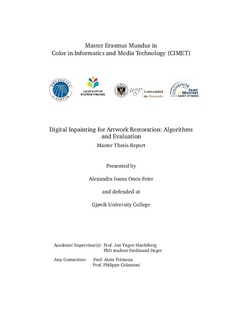| dc.description.abstract | Digital image inpainting refers to a technique used for filling in the missing or corrupted regions of an image using information from the surrounding area. Inpainting techniques have found widespread use in applications that include, but are not limited to error recovery, red-eye removal, multimedia editing. This thesis will discuss inpainting techniques in the context of digital artwork restoration. Due to an extensive research in the field of digital inpainting and to rapid advances in technology, new and improved inpainting techniques are continuously proposed. Improved digital image inpainting algorithms could provide substantial support for future artwork restoration. However, as the latter is characterised by a high demand in quality, methods for an accurate evaluation of the performance of inpainting algorithms are needed. A literature review showed however, that currently, there is an acknowledged lack of quantitative metrics for image inpainting evaluation. In this thesis the performance of eight representative inpainting algorithms will first be evaluated by means of a psychophysical experiment. Based on the obtained perceptual data, a ranking of the algorithms will be established, that confirms that exemplar based methods generally outperform Partial Differential Equation based methods. Two novel inpainting quality metrics, proposed in this thesis, eight general image quality metrics and four quality metrics specially developed for inpainting assessment will then be evaluated against human observers. Two types of evaluation will be carried out; one investigates the performance of the metrics over the entire image database considered, and the other assesses the correlation of the metrics for individual images. Results show that none of the considered metrics can adequately predict inpainting quality over the entire image database, and that the performance of the metrics is imagedependent. The two newly proposed metrics outperform some of the existent inpainting quality metrics for the first type of evaluation. However, additional work is needed to find metrics that correlate well with the percept. | no_NO |
